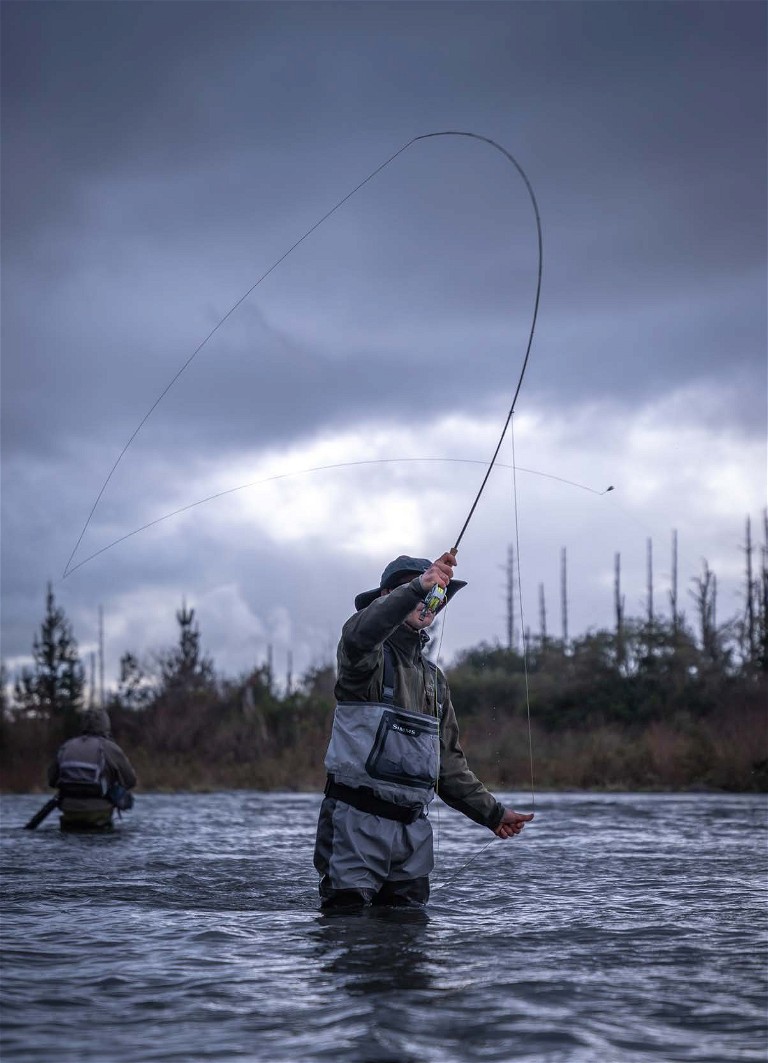FLY FISHING FOR DUMMIES
Words & Images by Andrew Harding
AN OLD DUFFERS SPORT?
It’s not hard to see why fly fishing has traditionally been the butt of more than a few jokes within the fishing community: oddly dressed men and women, decked out in camo, wearing 70’s style pornstar vests and hats that would be more at home on the parcel shelf of a white Nissan Maxima, all the while targeting an ‘invasive pest’ species, flailing away with a long stick in hand, hooking fish only to let them go again… sounds a bit naff, doesn’t it? But is this the reality of this sport? Not one bit! As a lifetime saltwater fisho too, I can tell you that fly fishing is actually an extremely addictive and beautifully simple method of catching fish!

Are most fly fishers in it for a feed? No, not really. I personally think eating trout is like chewing on a corrugated cardboard box (ever wondered why chefs seemingly add a kilo of salt to any trout recipe?!), but the thrill that comes from targeting this wily species and fooling them in the most beautiful surroundings, with the ensuing fight and lasting memories, will have even the most ardent saltwater angler hooked. Fly fishing is hunting in its simplest form: the stalk, the cast, the hook – not to mention the great exercise and mental well-being you get from being out there doing it.
GLASS IS KING
Despite what the glossy advertisements suggest, you don’t need the best, highend gear. However, a few key pieces of equipment will help get you started in fly fishing. The first, most essential item you’ll need is a good pair of polaroid sunglasses. No, I’m not talking about the $20 service station polycarbonates, but a good pair of glass-lens, polarised glasses. Fly fishing is a visual sport; you tend to spot your quarry first, be it in a lake or river, and you need to be able to see in the direct sun, through surface glare, wind, and rain. Don’t skimp on glasses. It would be like going hunting without a scope on your rifle!
WHAT NEXT?
Rock on up to a river, chuck a fly out on a 5/0 recurve hook, and wait? Well, nope. Learning to cast can be a time-consuming process, made all that much faster by joining a local flyfishing club or enlisting the services of a local guide. While booking a guide is the more costly option, you can always grab a mate who’s keen to split the cost; a guided day will ensure you’re well on your way to mastering all facets of the sport in a fraction of the time. It’s money well spent.
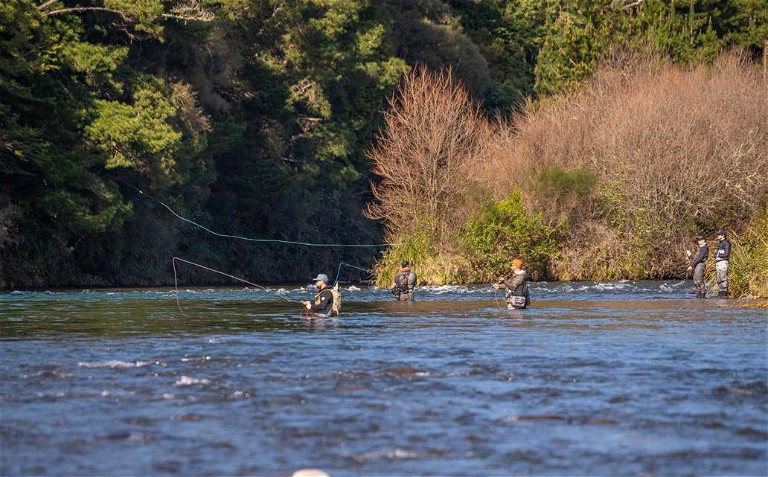
WHERE TO GO?
New Zealand is blessed with water. We have oodles of it. And almost every region (except for the Far North) has waterways containing trout or other freshwater sportfish, such as perch. One of the best learning locations is a local lake or pond, which are often stocked with trout by local Fish & Game entities. If there are fish there, you can fool them, and you’ll learn so much about trout feeding behaviour in these places. These types of ‘bread and butter’ fisheries provide an extremely valuable learning curve for budding fly anglers as all trout, in their simplest form, feed and behave the same no matter where you are.
Fish & Game New Zealand also provide anglers with basic access pamphlets – which are available online and in-stores – to various waterways around the country. Grabbing copies of the excellent — if a little outdated — books by John Kent, ‘North and South Island fishing guides’, provide a very good starting point for where to go fishing.

GET A LICENSE
Don’t forget you will need a license to fish for any freshwater sportfish (trout, salmon, or perch) within New Zealand. Whilst some baulk at the cost of a yearly license, the reality is it is the best bang-for-buck freshwater fishery on the planet by a long shot and in the grand scheme of things, incredibly good value for money.
WATCH YOUTUBE!
With an unlimited resource of videos on YouTube, you can watch how-to fly fishing videos till you go blue in the face. While some videos are focused on American or European fisheries, there are numerous how-to clips that apply to New Zealand waters as well. Fill your cup here until you are comfortable that you understand the basics and feel sufficiently inspired to hit the rivers/ lakes.

THE POINTY BITS
Next, it’s simply a matter of traipsing down to your local angling shop or online retailer and picking out a fly rod, reel, and line combo. As a starter, something like a 9-foot rod in a 6-weight configuration is ideal. Match this with a suitably sized 5 or 6-weight reel and a WF6F (weight forward 6-weight floating line), and you’re in business!
Of course, let’s not forget the pointy bits that you’ll need to catch said trout: the flies themselves! With soooo many different varieties to choose from, it can be daunting. But best to keep it simple! I only use a few patterns and have been doing so for over 30 years. A small fly box with some cicada patterns for high summer, some ‘royall wullf’ dry flies to use an indicator fly yearround (an indicator is a very visible fly or tuft of coloured yarn that enables you to see when a trout has taken the fly), and lastly, some nymphs. Nymphs are what make up approximately 90% of a trout’s diet and what you will be using basically year-round outside of January-March when the cicadas are abundant. As an aside, fishing cicada dry flies is arguably the easiest method of flyfishing and also the most exciting! You can slap ‘em down with no grace or technique at all; in fact, it’s preferable!
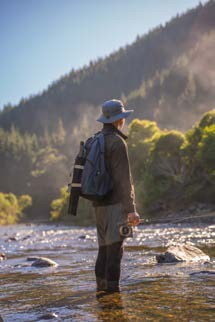
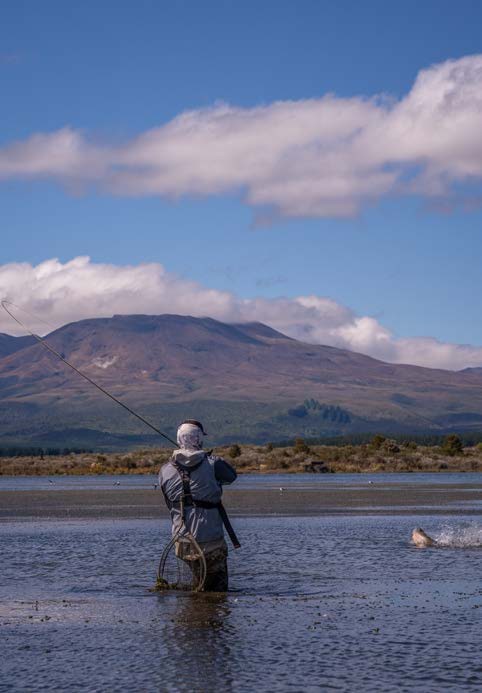
“ Fly fishing is an extremely addictive and beautifully simple method of catching fish. ”
Now, trout flies are generally small. If your sight is getting a bit iffy, such as happens to many of us when we hit fifty, you may struggle with tying the thin nylon (called tippet) through the eye of the hook. Some clip-on magnifying glasses will help here. On the subject of tippet, casting a fly is all about the transfer of energy: a smooth transition from the cast to the delivery of the fly, touching it down on the water’s surface as gently as possible to avoid spooking the trout. To facilitate this, you’ll use a tapered leader: an inexpensive, typically 9-foot section of monofilament with a fat end… and a skinny end! To this skinny end we tie the tippet. The tippet can be anywhere between 2 feet and 6 feet, depending on the circumstances. Most beginners will find casting a shorter leader and tippet easier, but once you’ve mastered the cast, using leaders of up to 20 feet total in length will provide a better buffer between you and the trout and in general, give you a far great success rate of hookup.
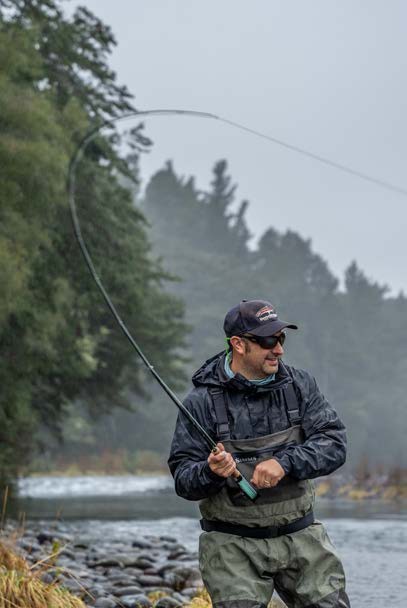
WADERS?
You know… those dorky-looking things that look like oversized baby pants? While you can wet wade (wear shorts and boots) in New Zealand through the warmer months, waders will be a key piece of kit when it gets colder. With varying costs associated with longevity and fabric technology, a cheap pair of PVC or second-hand Goretex waders will help you get on the water – make sure to layer up with a pair of polypropylene/woollen long johns underneath for extra warmth.
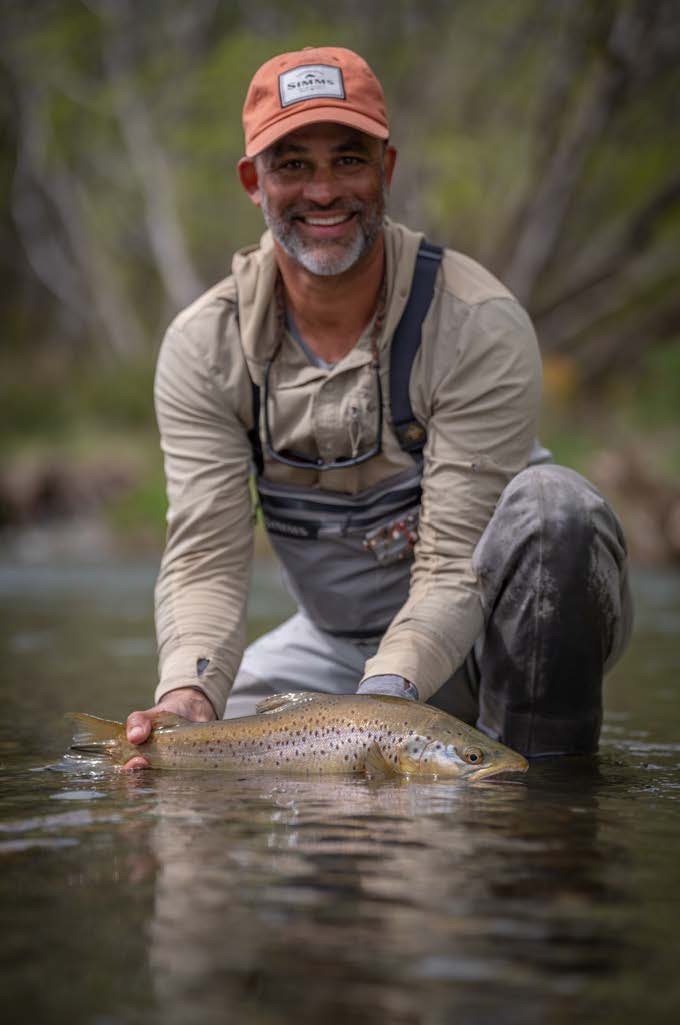
“ Fly Fishing is hunting in its simplest form: the stalk, the cast, the hook – not to mention the great exercise and mental well-being you get from being out there doing it. ”
WHERE TO FIND TROUT?
In lakes: look for stream inflows and fish cruising along weed beds and steep drop-offs. In rivers: during summer, trout will often be found in the bubbly, well-oxygenated water found at the head of pools, while during the cooler months, they tend to expend less energy and can be typically found in slow, deep pools.
Give fly fishing a go this winter! The Central North Island is a particularly popular destination where anglers can target beautiful big bars of silver that transcend the rivers on their annual spawning runs. It’s also a fantastic opportunity to catch up with mates – the camaraderie and banter often more enjoyable than the fishing itself.
